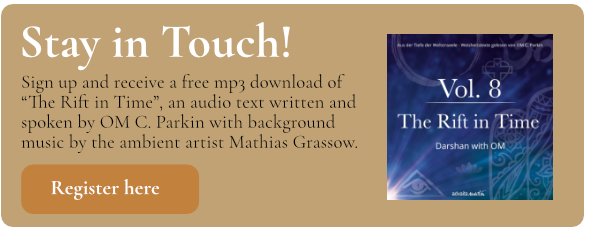OM about Teaching
“We become what we already are.” That is the fundamental paradox of the inner path, a koan, which can only be resolved by the union of a philosophy of becoming and a philosophy of Being.
The philosophy of becoming describes the great order of the evolution of consciousness, the unfolding of human intelligence, its perfection. Ramesh Balsekar called it “consciousness in movement”. It also describes the dualism of the manifest, of the relative world, in which subject and object are opposed to each other: the seer and the seen, I and you. I and we. I and the world. I and the SELF. Man and God.
The philosophy of Being describes the union beyond the world of phenomena. That-what-is, always was and always will be. Eternally. Non-duality. That which is not manifest. The Absolute. Ramesh Balsekar called it “consciousness at rest”.
The highest philosophy is neither a philosophy of becoming, of the manifold, nor is it a philosophy of Being, of union. It is a teaching of unification. A philosophy of BEING. Advaita, being the teaching of non-duality, can only be understood like this, because non-duality is neither duality nor unity. Sri Aurobindo called the teaching of unification Integral Yoga. The union of becoming and Being, of the descending and the ascending paths, of Yin and Yang, of Love and Truth.
In order to walk on the path of the unfolding of the soul, “conscious effort” (Gurdjieff) is needed at first. “This means a turn to the inside, a turn of the attention of 180 degrees inward. It initiates the treading of, the Inner Work of an inward-turned inner path.” (Intelligenz des Erwachens, p. 196). Ordinary man, people of the outer path, do not accomplish these efforts. Their inclination to comfort does not consider it necessary, their search for fulfillment drives them outside into the world. All human beings are seekers, but few are really seeking in the world that we call inside. Wisdom teachers of all times and traditions have unitedly been pointing to the inner gate. Only he who passes the inner gate, past the guardians who test him, finds bliss. A bliss of which the masters report to us, not to be confounded with the transient happiness of human love or other (transitorily) fulfilled wishes. A bliss of BEING. A bliss that neither comes, nor goes, because it is an immanent ‘taste’ of realised human nature. Even during painful experiences, the one who is conscious of himself does not lose this latent ‘taste of BEING’. All conscious efforts of the inner path that happen in pure intent will sooner or later uncover this ‘taste of BEING’.
“If you want to stay a normal person, just a seed of your own potential, then you do not need Inner Work....but if you want to live as a human being, then you have to exert a certain effort in order to recognize how Inner Work is the life-saving leash for real life”, writes spiritual teacher Almaas, who leads an inner school in the United States.
There are two formulated gaols of the inner path: firstly the ripening towards the state of human adulthood and secondly the awakening of man into his true nature. “The spiritual path is not for children”, that is how I sometimes describe the fact that the entrance into the spiritual sphere presupposes an adult human foundation. Thus a great part of applied Inner Work does not yet directly serve the awakening to the true SELF, but to remove mental and emotional obstacles that stem from an imagined, childlike past, so that the inner gaze - pure and clarified - can look at the essential, at the exploration of true Being. Usually, only a relatively relaxed mind, only a relatively peaceful mind with little subconcious driving power is able to do this.
The most direct path, the ‘pathless path’, is the direct view of the Absolute. The seeing of the SELF. Darshan. This radical, direct view, penetrates everything, even the concept of a path that has to be trodden: mysticism is the turn towards formless awareness. It is the innermost, the core of every religion, of every spiritual path. Indian wise man Ramana Maharshi taught as its sole means Self-Inquiry through the question "who am I"? I have called it great Self-Inquiry and opposed it to the small self-inquiry, which happens through the inner disciplines of the path. It asks: Who am I not? In an integral, unifying understanding, this inner practice of the path - the Inner Work- serves the unveiling, even the emptying of the mind's world and makes possible the mystical view. The small self-inquiry serves the great Self-Inquiry. Expressed in an image: If the sky is full of clouds, the awareness of the sky is at first limited, because consciousness is busy with the clouds, not with the sky. Whereas if the sky is free of clouds, then the inner view is also free.
The student: “Master, what are the stations of the path?” The master: “The search. The end of the search. The path. The end of the path. The path.”
Commentary: When the search is at an end, the path begins. When the path is at an end, the path begins.
